Art Installation Documentation
Artist Statement
Our installation is a representation of the permanence of waste in our environment. The prevalence of plastic waste in particular is especially harmful because of its durability. The plastic we produce does not just go away: it makes its way into our streets, streams and oceans. However, we do not necessarily see its everlasting presence in our oceans as we go about our daily lives. This piece aims to shed light on this issue by creating a source of water we do commonly see, rain, but created entirely out of waste in an effort to force us to reconsider the amount of waste, especially single-use disposables, we produce on a daily basis.
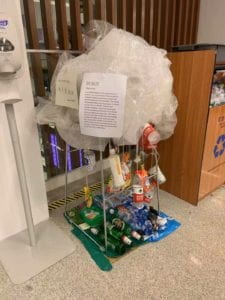
Process
We started off by separating and categorizing all of the trash we had collected and found that we had a large amount of plastic bags, bottles, food packaging and bubble wrap, as well as a few cardboard boxes.
For the clouds of the piece, we took the bubble wrap and attached it to one of the cardboard boxes to give it a “cloud-like” texture.
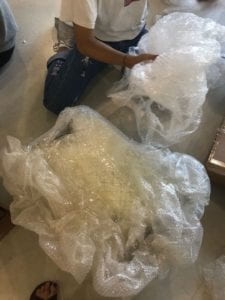
For the trash rain, we made string by cutting strips from plastic bags and twisting them together. We then used this plastic string to tie various pieces of trash.
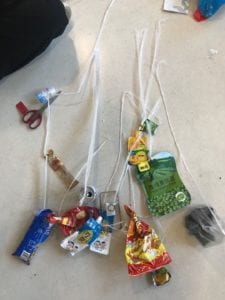
Lastly, the land and water component for the bottom was made out of trash that was mostly green and blue. We used a piece of cardboard as the platform, covered it in pieces of plastic bags to solidify the colors, and then placed the other trash components on top.
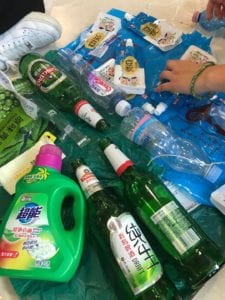
Ideally, we wanted to hang the piece in the cafe but this proved to be more difficult than we thought. The placement ended up being on a bench next to the waste bins in order for students and staff to consider their waste use as they are throwing it away.
Reflection
Overall, I’m satisfied with the piece but there are definitely aspects we could have improved. There was one new material we used that was not part of the waste we collected, and that was the tape we used to tape the bubble wrap to the cardboard boxes for the clouds. A way we could have avoided this was perhaps using more string made from plastic bags, or even ripped tape from the cardboard boxes.
Another aspect that could be improved is the presentation. I’m not sure placing it next to the trash bins is effective, considering we are not necessarily trying to encourage people to properly dispose of their single-use disposables, but rather discourage people to use them in the first place. It might have been more effective to place the installation closer to the cafe where the snacks and bottled drinks can be purchased in an effort to have people reconsider buying these items.
Trash Map
For the trash map, we decided to divide into two different groups: the research group and the visualization group. I was part of the research group, where we went on a little investigation to find out where our school’s trash was going.
We started out by thinking about the various places that you could discard of your waste, and what kinds of waste you could dispose of in each place. In the classrooms, hallways and second floor cafe, you can dispose of recyclable, residual, and household food waste. The B1 cafeteria is structured a little differently: you can dispose of recyclables and food waste, and a special bin labeled “paper” (napkins).
We then wanted to know where this trash went once it was inside the bins. We spoke to an ayi who was collecting trash from a classroom on the second floor, who told us after she collects the trash from the bins she takes it to the B2 parking garage.
We then went to the B2 parking garage and walked around until we found the waste area, which was divided into household food waste, other waste, harmful waste, recyclable waste and residual waste.
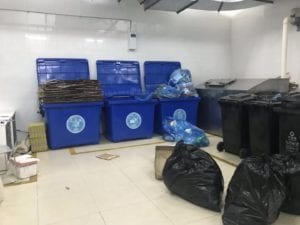
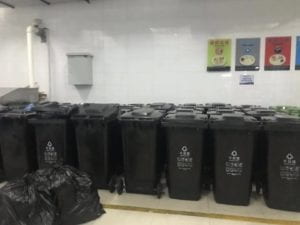
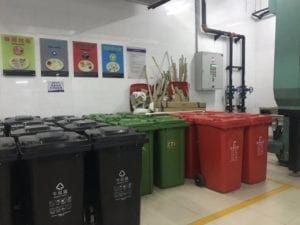
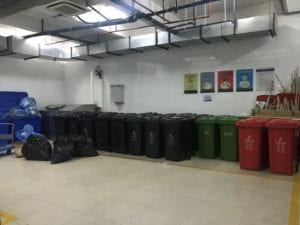
There was a man working there when we saw the room, so we asked him where the trash goes after it’s brought to B2 — he told us a garbage truck comes everyday from 1-3pm except on Sundays (…if I understood that Chinese correctly). However, he was not sure where exactly the truck took the trash.
After this little investigation, the visualization group created this beautiful trash map:
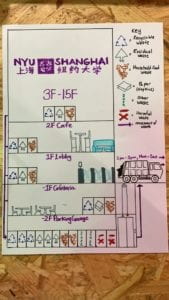
I think the language barrier was a bit of a limitation in getting all of the answers we were seeking. I’m still curious as to where exactly the garbage truck takes the trash everyday, as well as whether or not all of the trash is truly properly sorted when it goes out (and if not, who is responsible for making sure it is).
Thoughts on Readings
In The Concepts of Sustainability, it is brought up that the current ways of sustainability do not properly balance the “equity” component. However, I would think that consumers’ increasing awareness of environmental problems would provide more opportunities for companies to be visibly sustainable and market themselves as such to appeal to more consumers.
The informal sector of waste management as presented in Shanghai’s Informal Waste Management Project also shows that there is indeed an opportunity for economic gain in the sustainability realm. However, this brings up the question of how exactly the government would be able to formalize the process without getting rid of the current economic incentive for informal workers to collect, sort and sell waste. It was interesting how one of the quotes in the presentation mentioned how “the government is trying hard to shut us down.” It makes sense for the government to want proper regulation over the waste management system for tracking and policing reasons, but I wonder if there is a way to do both this and keep those 3.3 to 5.6 million people in China’s informal industry employed.
Leave a Reply